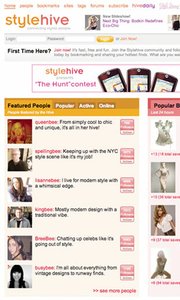Connecting Fashionistas Through Social Networks
The Web and blogging are now bringing images straight from the runway to the consumer faster than ever. The Web has also become a place for like-minded fashion seekers to share their style and connect with others through social-networking communities.
Following the lead of social-networking Web sites such as MySpace and Facebook, fashion-community sites bring users together through shared common interests—from finding new products to posting favorite pieces to links to completed look books to sharing personal style tips. While fashion networks make up a small percentage of the Web’s social-networking sites, fashion and shopping social networks are expected to grow, according to several Web-marketing analysts.
Online shopping and social networking are communal activities that go hand in hand. According to an August 2007 report by comScore, more than 95 percent of heavy social networkers visited retail sites, compared with 80 percent of the total U.S. Internet audience, with 24.8 percent of networkers visiting apparel sites.
Manish Chandra, founder and chief executive officer of Sunnyvale, Calif.–based shopping community site Kaboodle (www.kaboodle.com), saw an opportunity to combine the rise of e-tail with the popularity of social networking in 2006, when he launched Kaboodle.
“Social Web was evolving, and we came up with up with the idea that integrated the process of gathering and collecting with shopping,” he said.
At 7 million unique monthly visitors, Kaboodle allows users to select and share goods with a click of a button and broadcast it across the Web. Kaboodle members can create lists of their favorites and add it to their blogs or Facebook pages. “We believe in complete syndication in and out of the site,” Chandra said.
Most fashion-networking sites work similarly, allowing users to create personalized profile pages to fill with links to finds and engage in discussion with other users.
“In the same way that blogs are breaking news faster than traditional media channels, social-shopping sites are bringing the latest fashion to consumers before traditional retail,” said Scott Morrow, president of Santa Monica, Calif.–based social-shopping site ThisNext (www.thisnext.com). “The speed of product discovery online is unprecedented, and consumers are increasingly offered product choice that meets their specific tastes and preferences. Fashion and apparel are becoming more democratic, more individualized and more accessible.”
As knowledgeable consumers share their preferences within online fashion communities, they help trends evolve.
“Because these are centered around community and people chat with each other, these sites can be very powerful,” said Samantha Durbin, editor of FabSugar (www.fabsugar.com), a fashion blog from San Francisco–based Sugar Inc., which also runs ShopStyle (www.shopstyle.com), a shopping community site. “A brand or retailer would be very smart to pay attention to the biggest sites in this arena. It’s free consumer research. It’s also fueling the fast-fashion trend. People are seeing the goods sooner and adopting trends faster.”
Retailers are jumping on the social-network bandwagon by creating community pages on their own Web sites. Wet Seal now features an online community in which users can create and share outfits through a personalized boutique. Hot Topic is launching a music-oriented community called ShockHound (www.shockhound.com).
“There’s nothing more important to a brand than brand loyalty, and there’s no better way to engender it than to reach out directly, one-on-one, to consumers,” said Chris Kensler, editorial director of StyleHive (www.stylehive.com), a San Francisco–based fashion community site.























